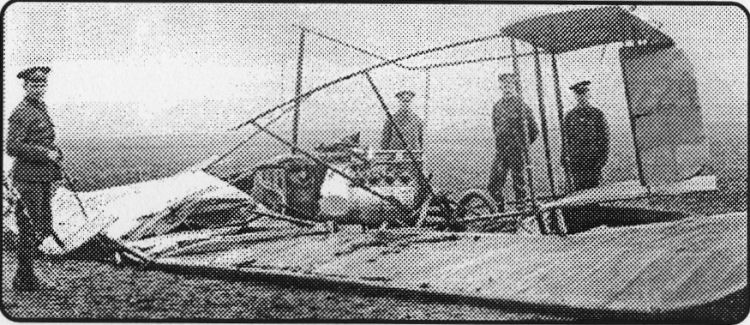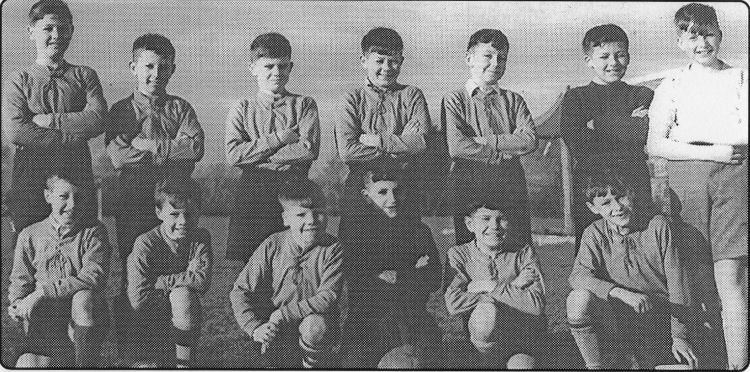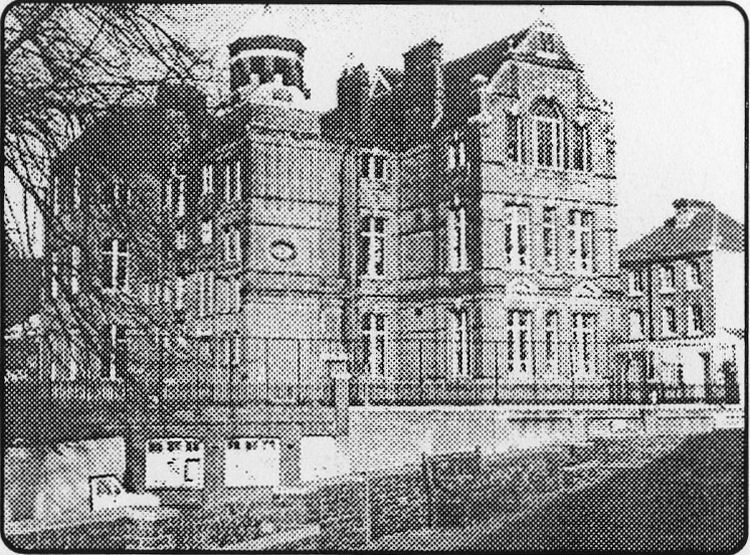
Published 7 November 2002



LOCAL aviation history enthusiast and author of several books, Roy
Humphreys, of Hawkinge, has identified the photograph of an aircraft crash
nearly 90 years ago which featured in Memories recently.
And he came up with another photo taken at the crash scene - a field near
Alderman Quested's Firs Farm - on October 22, 1913.
The Maurice Farman S.7 "Longhorn" aircraft was flown by Capt C. Mellor, a
pilot with the newly formed Royal Army Flying Corps. Lieutenant Gunter flew
with him as a passenger.
Both were injured when the aircraft, after a rather shaky take-off from 'Risborough
Field' got out of control and crashed. Gunter was pinned beneath the upper
wing of the plane and the pilot, who sustained three broken ribs, could not
move.
Among those apparently unimpressed with Capt Mellor's performance was the
matron of the Royal Victoria Hospital.
Strong tea warning!
Having heard that they had landed at 'Risborough Field' after giving a
flying display, to take tea in the Officers' Mess, she commented "they
should never drink strong tea when attempting to fly a flimsy, wood and glue
aeroplane!"
Capt Mellor had flown in from Farnborough and had been taking part in army
exercises near Dover along with the crews of two other aircraft.
The flying display had been for the benefit of Capt Mellor's old regiment,
the Royal Warwickshires, who were stationed at Shorncliffe Camp.
With his 70hp Renault engine giving trouble it took three attempts by Mellor
to get airborne and.
even then, one eye-witness at the Cottage Homes said the aircraft was "very
wobbly."
The plane turned rather abruptly after take-off, narrowly missing some
telegraph wires running alongside the railway and then appeared to be
heading towards the Cottage Homes.
At less than 200ft up Mellor quickly turned to the right but the Farman
dipped alarmingly - and then flopped in a heap of matchwood onto the
farmland.
The engine appeared to be enveloped in flames but soldiers of the Royal West
Kent Regt, from Dibgate Camp, threw earth over the hot engine to smother the
fire. An extinguisher was also used.
Roy Humphreys told me: "Cheriton photographer J. Coombes cycled to the crash
site at Firs Farm, eager to record for posterity something unusual and
perhaps a glimpse into the future."
My thanks go out to Tony Dickinson, of Wear Bay Road, Folkestone, who sent
me a 1950s photo of a St Peter's School football team via a friend of mine.
By coincidence / collected it from him just a day before my Memories page
reference was published about a St Peter's School appeal for old pictures
and memorabilia in connection with their forthcoming 130th anniversary
celebrations.
The photo dates from 1955 and the players are, back row, left to right. Tony
Dickinson. R Harrington, M Burton. / Webb. C Cook. M Wooderson. plus a
linesman; front row: A Harding, ...?.......?..., R
Pegdon, M Fagg and F MardeH.
Tony also sent me an interesting photo from the same year of the "Blessing
of the Fisheries" parade with fishermen's sons in the procession.
He recalls that the model of a fishing boat was always carried from St
Peter's Church on the Durlocks to the harbour for the blessing ceremony.
Ronald Dutt, 69, of St Michael's Street, who was
)
Pancaked!
ABOVE: A ST PETER'S School football team from 1955 - a photograph shown to
the Herald by Tony Dickinson, of Wear Bay Road, Folkestone, in response to a
plea for pictures for school birthday celebrations. TOP: A "box kite" Farman
aircraft which came to grief at Cheriton after a demonstration flight by a
RFC pilot.
a groundsman at Shorncliffe Camp for many years, is hoping to get former
pupils of the old Dover Road School together for a reunion of classmates of
the years 1945-48.
Those interested can contact him on 01303 254107.
Ron was among those who were evacuated to Wales during the war years. He was
in a small party of old boys who made a trip down memory lane in re-visiting
the Raglan area a couple of years ago.
A photograph taken of Dover Road School evacuees in Wales was published
years ago in the now out of print paperback "The Story of a School -Dover
Road, 1835-1958," by W.A. Parks.
Jeanne Brinton. Publicity Officer of Folkestone &
District Family History Society, seeks information and photos of Folkestone
Hockey Club, founded in 1906. Post or copying costs will be refunded, she
says. Jeanne can be contacted on 01303 226558 THE OIMCE familiar landmark of
Dover or via e-mau: Jbri999@ao .com D . c u , . . _, „ n ..
Road School, shown to me by Ron Dutt.
 |
Fumes protest as army plan Shomdiffe isolation hospital
■I QnO PLANS by the War Department for a military isolation hospitaldose
to the existing military hospital at Battery Point. There were said to
be complaints already about fumes from a "disinfector unit" built at the
hospital. Shorncliffe garrison church was a victim of sacrilege" by a
burglar who broke in, ransacked the building and tried to force the
safe. He also tore the alms box from the wall but netted only three
farthing coins - worth less than an old penny. War hero Lieutenant W
English VC came home from the war front in South Africa to take part in
Coronation ceremonies in London, and was expected to visit family in
Folkestone. The Herald backed efforts to make more of the Cinque Port of
Hythe as a winter resort, sheltered, as it was reckoned to be, from the
north winds. But, as with Folkestone, more seafront shelters were needed
in case of rain or snow. Progress had been made with the opening of a
golf course. Years ago, as a mark of respect for the dead and those who
grieve, it was an offence to smoke in a churchyard or cemetery in
Folkestone, not to mention taking short cuts through the graveyard with
your bicycle.
|
Grand plans by Council to mark Queen’s coronation
m QGO CORONATION Parade, was proposed .Lę70^as the new name for the East
Cliff promenade, which it was hoped to illuminate-and more shelters for
pedestrians, both at East Cliff and Madeira Walk were planned as part of
Folkestone's new amenities to mark the Queen's coronation year. The
Council was also thinking of an indoor swimming pool, replacement of the
Metropole Lift, the opening of a children's library and a cover building
for the Roman Villa it was also hoped to open up to the public, at East
Cliff. A Cheriton farmer was fined for moving three cows out of a 'foot
and mouth' infected area. The "Corporation of the Bailiff, Jurats and
Commonalty of the Liberty of Romney Marsh," a largely ceremonial body
today, held its 491st annual meeting at Dymchurch and the Herald
featured a photo of the oldest Jurat present Edward Lord, 89, of
Ruckinge, cutting an iced cake. Mr Lord, who succeeded his father as a
jurat told how, over his 60 years as a member of the ancient
corporation, its powers had been taken away. He urged that they try and
regain some of them. The Corporation's only income was from wrecks
washed up along the shoreline of the Marsh.
|
Channel swim triumphs -then doctor admits hoax
H THREE British women "succeeded" in
( Channel swims — Mercedes Gleitz, a typist, making her eighth attempt;
Mrs Ivy Gill, of Sheffield, and Dr Dorothy C Logan, of Hythe and Harley
Street who, landing at Folkestone, in 13hrs lOmins, was heralded as the
new women's champion. But controversy surrounded two swims. Miss Gieitz,
piloted by Folkestone fishing smack FE11 skippered by Harry Sharp, swam
in thick fog throughout and was said to have staggered ashore at St
Margaret's Bay and was brought back to Folkestone in a semi-con-scious
condition. Owing to lack of 'independent' witnesses there was doubt
about the swim, causing Miss Gieitz to make a "vindication" swim of 10
hours a fortnight later, watched by a "Daily Mail" aircraft. Dr Logan^
who swam under a pseudonym, came ashore near the Victoria Pier and was
acclaimed the new women champion but. a few days later admitted it was a
hoax. She swam for six hours then got onto her escort boat rested and
resumed her swim when three miles out. She said it was to demonstrate
how easy it was to fake a swim.
|
'Miracle’ detergent to fight oil pollution of the beaches
*1 077* MODIFIED light aircraft and a local t I fishing boat
demonstrated a new system to tackle oil pollution along the Channel
coast. The plane sprayed the sea with a disper-sant to help prevent oil
hitting the beaches. Gallons of crude oil was pumped into the sea and on
the sands and then sprayed with the dis-persant, the demonstration being
watched by 80 leading oil experts. In 30 seconds 80% of the oil was said
to have been dispersed and. after two further sprayings other stubborn
patches of oil were also dispersed. Teenage trouble spread across
Folkestone for the second time in a week, as rival school groups clashed
in and around Cheriton Road soccer ground where Folkestone beat Horsham
3-0. Two boys were treated in hospital after violence broke out and the
day ended with chanting fans marching noisily through Golden Valley
housing estate. Parents were fighting to ban industrial traffic from a
road running by three school complexes off Park Farm Road and the KCC
was investigating a safer access. Sixty-five members and friends of the
British Legion went to Boulogne to attend the unveiling of a new plaque
to the Unknown Warrior in Chateau d' Aumont. |
|




